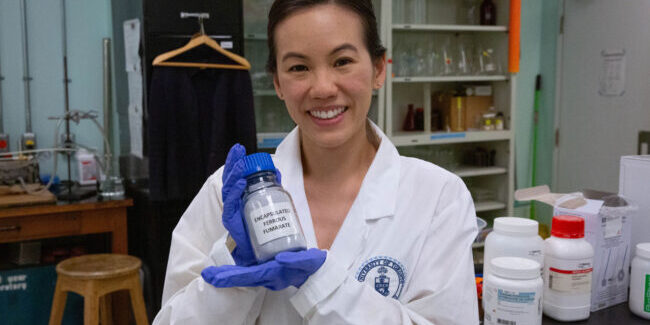A new commercial product, developed from U of T Engineering research, is poised to enhance durability and efficiency in battery casing for both electric and internal combustion vehicles.
Having just defended his PhD thesis, Nello D. Sansone (MIE PhD candidate) is also putting the final touches on a new advanced material formulation known as AX Gratek PP40. The material is 18% lighter and enhances structural performance by 20% over industry standards. It offers superior multifunctionality that cuts energy consumption, extends vehicle range and enhances sustainable transportation.
“AX Gratek PP40 battery casings enter production this spring, and will be integrated into upcoming models of commercial vehicles and available for consumer purchase later this year,” says Sansone, who is supervised by Professor Patrick C. Lee (MIE) in the Multifunctional Composites Manufacturing Laboratory (MCML).
“This has been a rewarding collaboration, which leveraged the expertise of Professor Lee, postdoctoral researcher Rafaela Aguiar, and Axiom’s leading engineers, managed by Matthew Leroux, to make this project a success.”
Sansone joined the MCML after earning his B.Eng. from Toronto Metropolitan University. During his graduate studies, Sansone saw his research goals aligning with the automotive industry need for lightweight and mechanically robust multifunctional materials in order to meet net-zero emission targets by 2050.
His thesis project focused on the design, synthesis, characterization and modeling of advanced hybrid composites and foams.
This collaboration secured multiple successful funding proposals and ultimately, established a long-term partnership with Axiom, a leading Tier 1 automotive parts manufacturer based in Ontario, Canada, supplying components to major OEMs including Tesla, Volkswagen, and Stellantis. The partnership has now spanned the duration of Sansone’s research work over six years (MASc. to PhD), facilitating applied research and engineering in advanced polymer systems for real-world applications.
Sansone says that he drew inspiration from nature, and he credits his family for setting him down this path.
“My drive to understanding intricate systems and material transformation began with hands-on experiences with my grandparents,” says Sansone, who will defend his thesis Harnessing Nature’s Synergistic Hierarchical Architecture for Next-Generation Bespoke Hybrid Composites this summer.
“Making things like homemade pasta and cured meats using food extruders, molds, and presses, subtly foreshadowed my interest in polymer processing.”
The experience of working on AX Gratek PP40 has inspired Sansone to continue his entrepreneurial journey. As a co-founder of start-up NanoMorphix, he is working on commercializing another of his patented material formulations: a self-healing transparent armor with applications ranging from automotive and aerospace bullet- and blast-resistant windows to advanced defense shielding technologies.
“From the incredible support and mentorship to the collaborative environment that fueled my growth, U of T has played a crucial role in shaping my career pathway,” says Sansone.
“The most rewarding aspect of this experience is not only completing my PhD dissertation but also seeing a commercialized product ready to launch before I even graduate. It’s a surreal and incredibly fulfilling achievement, and one I hope to pay forward through pedagogy and mentorship in the years ahead.”




